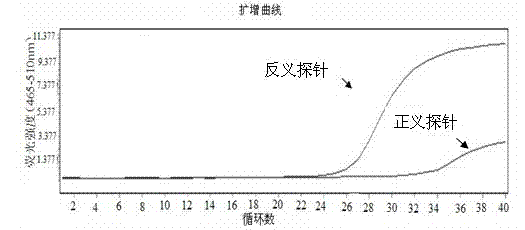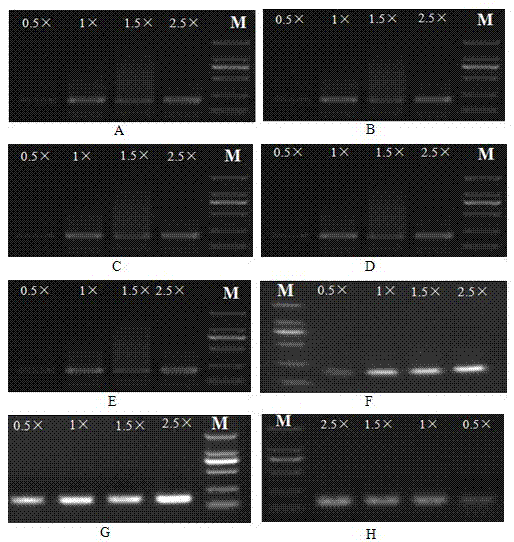EGFR (epidermal growth factor receptor) gene mutation site detection kit
A mutation site and kit technology, applied in the fields of biotechnology and medicine, can solve the problems of high cost, easy contamination, sensitivity, time-consuming, etc., and achieve the effects of high precision, good specificity and high sensitivity
- Summary
- Abstract
- Description
- Claims
- Application Information
AI Technical Summary
Problems solved by technology
Method used
Image
Examples
Embodiment 1
[0053] The human EGFR gene is located on chromosome 7 of the genome, the EGFR genomic DNA (Genebank: NG_007726.3), and the full-length cDNA encoding the EGFR gene is shown in SEQ ID No: 1. According to the patient's EGFR gene mutation mainly concentrated on exon 19 and exon 21, the sequence of EGFR gene exon 19 is shown in SEQ ID No: 2, and the sequence of EGFR gene exon 21 is shown in SEQ ID No: 3. The mutation sites of the EGFR gene are shown in Table 1:
[0054] Table 1. EGFR mutation sites
[0055] Construct positive quality control products in the EGFR gene hotspot mutation detection kit, specifically 2235-2249 deletion, 2236-2250 deletion, 2236-2253 deletion, 2239-2253 deletion, 2240-2257 deletion, Positive controls for the 2582-position missense mutation and 2573-position missense mutation are used as reference substances for the detection of the kit.
[0056] The above 7 kinds of positive control substances were cloned into the pGM-T vector by screening the corresp...
Embodiment 2
[0069] Use the primers in Table 2 and 7 positive control templates to carry out PCR respectively. The PCR Buffer concentration gradients in the PCR reaction are 0.5×, 1×, 1.5×, 2× and 2.5× respectively, and the concentrations of other components are the same (each in a 20 μL system The final concentrations of the components were 0.25mM dNTP, 2.5mM MgCl 2 , 1U / reaction DNA polymerase, 250nM primers, 30ng template DNA and the rest water). The PCR reaction conditions were: pre-denaturation at 95°C for 5 minutes, one cycle; 40 amplification cycles, deformation at 95°C for 20 seconds, annealing and extension at 60°C for 40 seconds; and finally cooling at 40°C for 15 seconds. The PCR amplification products were identified by electrophoresis, and the results were as follows: image 3 shown. Depend on image 3 It can be seen that the bands are amplified within the range of PCR Buffer concentration gradient of 0.5×~2.5×, and the result is the best when the PCR Buffer concentration i...
Embodiment 3
[0071] MgCl was carried out with the primers in Table 2 and 7 positive control templates respectively 2 PCR with different concentrations, and the conditions of other components are the same (the final concentration of each component in the 20μL system is 1×PCR Buffer, 0.25mM dNTP, 1U / reaction DNA polymerase, 250nM primer, 30ng template DNA, and the balance is water), MgCl 2 The concentrations were 1.5mM, 2.0mM, 2.5mM, 3.0mM and 3.5mM. The PCR reaction conditions are the same as in Example 2, and the amplified product is identified by electrophoresis, and the results are as follows: Figure 4 shown. Depend on Figure 4 It can be seen that in MgCl 2 The target band was amplified in the concentration range of 1.5mM~3.5mM, when MgCl 2 It works best at a concentration of 2.0-2.5mM.
PUM
| Property | Measurement | Unit |
|---|---|---|
| Sensitivity | aaaaa | aaaaa |
Abstract
Description
Claims
Application Information
 Login to View More
Login to View More - R&D
- Intellectual Property
- Life Sciences
- Materials
- Tech Scout
- Unparalleled Data Quality
- Higher Quality Content
- 60% Fewer Hallucinations
Browse by: Latest US Patents, China's latest patents, Technical Efficacy Thesaurus, Application Domain, Technology Topic, Popular Technical Reports.
© 2025 PatSnap. All rights reserved.Legal|Privacy policy|Modern Slavery Act Transparency Statement|Sitemap|About US| Contact US: help@patsnap.com



